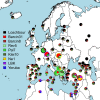Early farmers from across Europe directly descended from Neolithic Aegeans
- PMID: 27274049
- PMCID: PMC4922144
- DOI: 10.1073/pnas.1523951113
Early farmers from across Europe directly descended from Neolithic Aegeans
Abstract
Farming and sedentism first appeared in southwestern Asia during the early Holocene and later spread to neighboring regions, including Europe, along multiple dispersal routes. Conspicuous uncertainties remain about the relative roles of migration, cultural diffusion, and admixture with local foragers in the early Neolithization of Europe. Here we present paleogenomic data for five Neolithic individuals from northern Greece and northwestern Turkey spanning the time and region of the earliest spread of farming into Europe. We use a novel approach to recalibrate raw reads and call genotypes from ancient DNA and observe striking genetic similarity both among Aegean early farmers and with those from across Europe. Our study demonstrates a direct genetic link between Mediterranean and Central European early farmers and those of Greece and Anatolia, extending the European Neolithic migratory chain all the way back to southwestern Asia.
Keywords: Anatolia; Greece; Mesolithic; Neolithic; paleogenomics.
Conflict of interest statement
The authors declare no conflict of interest.
Figures



References
-
- Bramanti B, et al. Genetic discontinuity between local hunter-gatherers and central Europe’s first farmers. Science. 2009;326(5949):137–140. - PubMed
-
- Skoglund P, et al. Genomic diversity and admixture differs for Stone-Age Scandinavian foragers and farmers. Science. 2014;344(6185):747–750. - PubMed
-
- Weninger B, et al. Neolithisation of the Aegean and Southeast Europe during the 6600–6000 calBC period of Rapid Climate Change. Documenta Praehistorica. 2014;41:1–31.
Publication types
MeSH terms
Associated data
- Actions
- Actions
Grants and funding
LinkOut - more resources
Full Text Sources
Other Literature Sources
Miscellaneous

